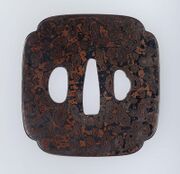Mokume
Jump to navigation
Jump to search
Description
A decorative wood grain pattern produced by laminating thin layers of various materials. Mokume has been used in Japan since at least the 17th century to make veneer papers, tsubas (sword guards), and, more recently, to make jewelry. For metals, thin alloy layers with varying compositions are forged together, then sometimes cut or folded then reforged. In the final product, the colors of the layered pattern are enhanced by dipping the piece in an acid etch bath or patinating solution. A patinating solution called rokusho contains Copper acetate, Copper sulfate, and Sodium chloride, is typically used to color precious metal alloys containing Gold, Silver, and Copper.
Synonyms and Related Terms
mokume-gane; mokume damascus; rokusho
Resources and Citations
- Ian Ferguson, Mokume Gane, Krause Publications, Wisconsin, 2004.
- E.J.LaBarre, Dictionary and Encyclopedia of Paper and Paper-making, Swets & Zeitlinger, Amsterdam, 1969
- A History of Technology, Charles Singer, E.J. Holmyard, A.R. Hall (eds.), Clarendon Press, Oxford, Volume 1: From Early times to Fall of Ancient Empires, 1954
- Wikipedia: http://en.wikipedia.org/wiki/Mokume-gane (accessed Dec. 4, 2004)
